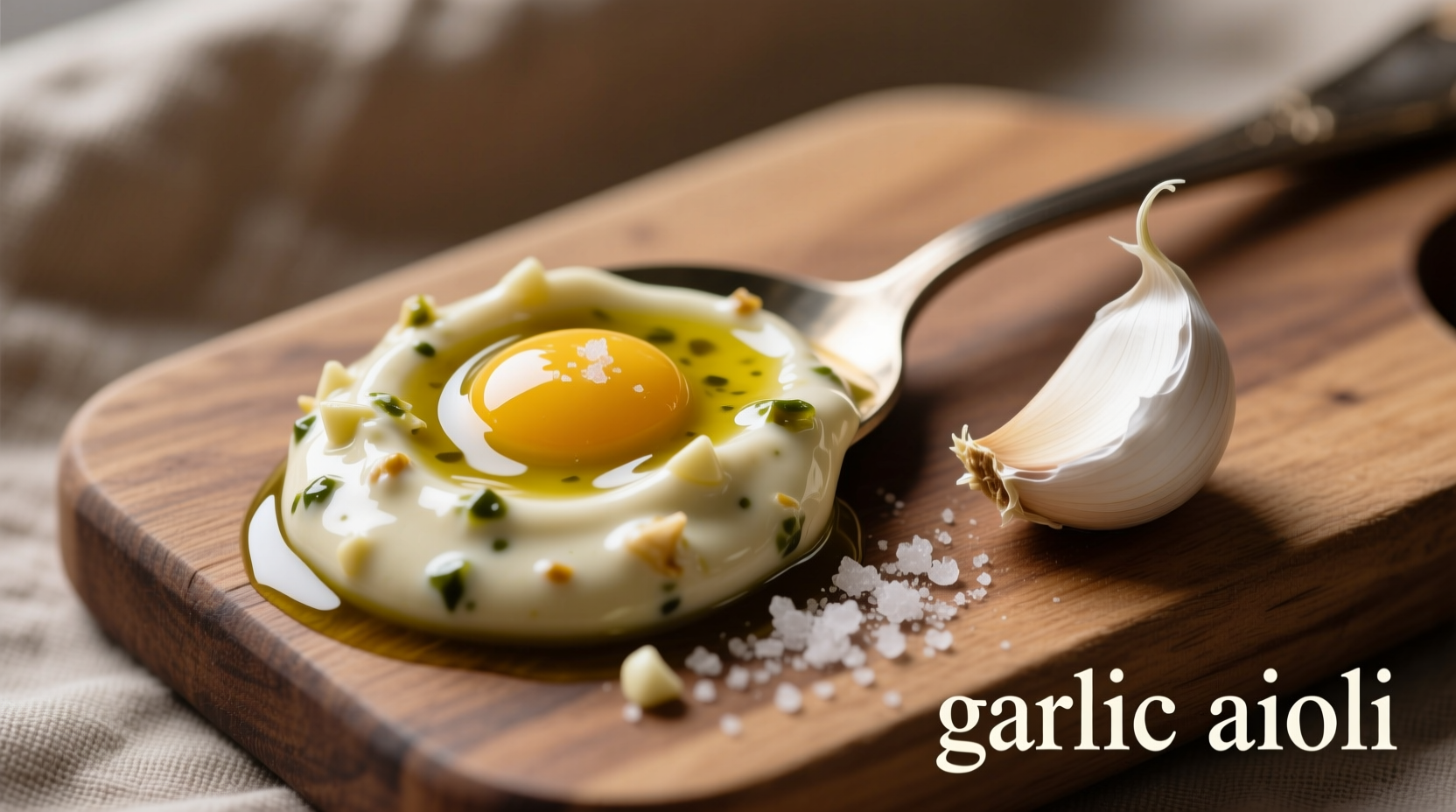Forget store-bought versions loaded with preservatives and artificial flavors. Creating authentic garlic aioli sauce from scratch transforms ordinary meals into extraordinary culinary experiences. Whether you're preparing a simple weeknight dinner or hosting a special gathering, this foundational sauce adds professional-quality flavor with minimal effort.
The Essential Components of Perfect Garlic Aioli
Understanding the role of each ingredient ensures consistent results every time. Traditional garlic aioli relies on five core components that work together through emulsion science:
- Fresh garlic - Provides the signature pungent flavor that mellows when emulsified
- High-quality olive oil - Creates the rich base and carries flavor compounds
- Egg yolks - Natural emulsifiers that bind oil and liquid components
- Lemon juice - Adds brightness and stabilizes the emulsion
- Sea salt - Enhances flavor and helps break down garlic compounds
Professional chefs emphasize that ingredient quality directly impacts final flavor. "The olive oil you select becomes the flavor foundation," explains Sophie Dubois, French-trained chef specializing in European spice traditions. "Extra virgin olive oil with fruity notes balances garlic's intensity better than neutral oils."
| Ingredient | Traditional Ratio | Flavor Impact | Substitution Options |
|---|---|---|---|
| Fresh garlic | 2-4 cloves per serving | Sharp, pungent base note | Roasted garlic for milder flavor |
| Olive oil | 1 cup per yolk | Fruity, grassy backbone | Avocado oil (less traditional) |
| Egg yolks | 1 per 1 cup oil | Creamy richness | Aquafaba for vegan version |
| Lemon juice | 1 tbsp per yolk | Bright acidity | Vinegar (different flavor profile) |
Step-by-Step Preparation Guide
Follow this professional method for foolproof garlic aioli every time. The key lies in proper emulsion technique rather than special equipment.
- Prepare the garlic base - Mince 2-4 garlic cloves finely and mash with 1/4 teaspoon sea salt into a smooth paste using a mortar and pestle or knife edge
- Combine wet ingredients - Whisk 1 large egg yolk, garlic paste, and 1 tablespoon lemon juice until fully incorporated
- Slow oil incorporation - Gradually drizzle 1 cup extra virgin olive oil in a thin, steady stream while whisking constantly
- Adjust consistency - Add water (1 teaspoon at a time) if too thick, more oil if too thin
- Season to perfection - Taste and adjust salt, lemon, or garlic as needed
The most common mistake home cooks make? Adding oil too quickly. "Emulsification requires patience," Dubois emphasizes. "Pouring oil too rapidly breaks the emulsion, resulting in separated, watery sauce." If your aioli breaks, whisk in 1 teaspoon warm water to reconstitute the emulsion.

When Garlic Aioli Shines: Contextual Applications
Understanding where garlic aioli performs best prevents culinary missteps. This sauce excels in specific contexts while falling short in others:
- Ideal applications: Seafood accompaniments, roasted vegetable dips, sandwich spreads, grilled meat sauces, potato salads
- Limited effectiveness: With strongly spiced dishes (masks aioli's subtlety), acidic preparations (competes with lemon notes), hot soups (breaks emulsion)
- Temperature considerations: Best served chilled or at room temperature; prolonged heat exposure causes separation
Historically, garlic aioli evolved from Mediterranean coastal communities where olive oil and garlic were abundant. The traditional mortar-and-pestle preparation method dates back to Roman times, with documented references in 14th century Catalan cookbooks. Modern variations incorporating egg yolks emerged in the 19th century as culinary techniques advanced.
Storage Guidelines and Shelf Life
Proper storage maintains both safety and quality. Homemade garlic aioli contains raw egg, requiring careful handling:
- Refrigerate immediately in airtight container
- Consume within 3-4 days for optimal freshness
- Discard if separation cannot be fixed by stirring
- Never leave at room temperature more than 2 hours
For extended storage, consider egg-free variations using aquafaba or commercial emulsifiers. These vegan alternatives maintain quality for up to 7 days refrigerated. Always check for sour odor or visible mold before using.
Popular Variations to Explore
Once you've mastered the classic garlic aioli recipe, experiment with these chef-approved variations:
- Lemon-herb aioli - Add 1 tablespoon each fresh parsley, chives, and dill
- Roasted red pepper aioli - Blend in 2 tablespoons roasted peppers for sweetness
- Spicy harissa aioli - Mix in 1-2 teaspoons harissa paste for North African flair
- Truffle aioli - Stir in 1/2 teaspoon truffle oil for gourmet touch
"The beauty of garlic aioli lies in its adaptability," Dubois notes. "Each variation maintains the essential emulsion while introducing complementary flavors that enhance specific dishes." When creating custom blends, add additional ingredients after the base emulsion forms to prevent separation.
Troubleshooting Common Issues
Even experienced cooks encounter challenges with garlic aioli preparation. Here's how to address frequent problems:
- Too thin - Whisk in additional oil (1 tablespoon at a time) until proper consistency
- Too thick - Incorporate cold water or lemon juice (1 teaspoon increments)
- Overpowering garlic - Balance with additional lemon juice or a pinch of sugar
- Broken emulsion - Start new base with 1 teaspoon water, slowly incorporating broken mixture
For consistent results, use room temperature ingredients and maintain steady oil drizzling speed. Professional kitchens often use immersion blenders for foolproof emulsification, though traditional whisking develops better flavor integration.
Frequently Asked Questions
These common questions address practical concerns home cooks encounter when preparing garlic aioli sauce:











 浙公网安备
33010002000092号
浙公网安备
33010002000092号 浙B2-20120091-4
浙B2-20120091-4